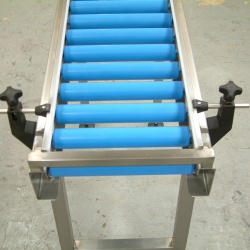Thanking Wikipedia for it post on belt conveyors.
A conveyor belt (or belt conveyor) consists of two or more pulleys, with a continuous loop of material – the conveyor belt – that rotates about them. One or both of the pulleys are powered, moving the belt and the material on the belt forward. The powered pulley is called the drive pulley while the unpowered pulley is called the idler. There are two main industrial classes of belt conveyors; Those in general material handling such as those moving boxes along inside a factory and bulk material handling such as those used to transport industrial and agricultural materials, such as grain, coal, ores, etc. generally in outdoor locations. Generally companies providing general material handling type belt conveyors do not provide the conveyors for bulk material handling. In addition there are a number of commercial applications of belt conveyors such as those in grocery stores.
The belt consists of one or more layers of material they can be made out of rubber. Many belts in general material handling have two layers. An under layer of material to provide linear strength and shape called a carcass and an over layer called the cover. The carcass is often a cotton or plastic web or mesh. The cover is often various rubber or plastic compounds specified by use of the belt. Covers can be made from more exotic materials for unusual applications such as silicone for heat or gum rubber when traction is essential.


